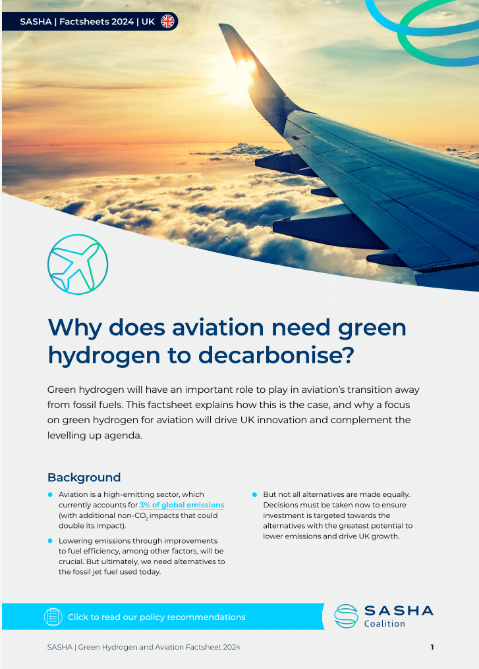Getting the facts straight on green hydrogen in an election year
Whether or not the EU and UK will meet their climate targets hangs in the balance this year with elections just around the corner. We’ve published a set of factsheets to help decision makers drive the right policies to decarbonise shipping and aviation by 2050.
1. Context – upcoming UK and EU elections
The EU’s June elections, and the UK general election (to take place within the next year) will directly affect shipping and aviation decarbonisation targets. Incoming governments’ green investment decisions for the coming years will make or break these sectors’ decarbonisation trajectories for the following decades.
A key dynamic that cannot go overlooked in these election cycles is that just as green investment drives decarbonisation, decarbonisation is itself a fruitful path to economic growth.
Building a thriving green hydrogen industry to cut shipping and aviation emissions would dovetail neatly on key election focusses on growth, levelling up and job creation especially in areas currently situated away from most economic activity. These opportunities are crucial for ensuring a just transition, helping industries and communities to transition away from fossil fuels successfully while leaving no one behind.
Read our EU Green Hydrogen factsheet here.
2. Main challenges with existing green hydrogen policy
In 2023, the UK Climate Change Committee said there are ‘no credible policies’ in place to decarbonise shipping. This statement probably refers to the shortcomings of the UK Clean Maritime Plan, which states that the majority of emission reductions will come from low or zero-emission fuels, while providing no regulatory framework to increase these fuels’ uptake.
For aviation, the UK government has committed to introducing a sustainable aviation fuel (SAF) mandate from 2025 onwards, with an equivalent of at least 10% of jet fuel to be made from sustainable sources by 2030. The plans for the mandate don’t yet contain any targets for green hydrogen fuels, but an accompanying mandate for e-fuels is currently under consultation and we expect to see the final results in the coming months.
Green hydrogen is included in the government’s Jet Zero strategy 2022 and Clean Maritime Plan 2019, as well as its UK Hydrogen Strategy 2021 that aims to produce 10GW of low-carbon hydrogen production capacity by 2030, at least half of which will be green hydrogen. But green hydrogen production in the UK will need to be scaled up massively to meet projected shipping and aviation decarbonisation needs.
In the EU, the FuelEU Maritime Initative calls for an 80% reduction in the greenhouse gas intensity of shipping fuels by 2050. This lags behind both the Paris Agreement targets, and the 2023 International Maritime Organization (IMO) strategy, which aims for a 30% reduction in emissions by 2030, 80% by 2040 and zero in 2050.
FuelEU Maritime also includes a 2% synthetic fuels usage target by 2034, including hydrogen-derived fuels. But this new regulation will only be introduced if synthetic fuels amount to less than 1% in the fuel mix in 2031 – which is much too low.
For aviation, ReFuel EU Aviation sets a target for fuel suppliers to incorporate 6% SAF in 2030, but only 1.2% synthetic fuels (including green hydrogen-derived). This target will rise to 70% SAF and 35% synthetic fuels by 2050. The regulations’ focus on biofuels for aviation also risks creating incentives for deforestation.
The EU Hydrogen Strategy 2020 recommended policy actions in research and collaboration, international cooperation, building a market and infrastructure for hydrogen, investment assistance, and production and demand support, all implemented by 2022. However, despite these positive steps, there’s no harmonisation between this approach and shipping and aviation regulation, and green hydrogen’s integral role has been neglected in both the FuelEU Maritime and ReFuelEU Aviation initiatives.
Read our UK Shipping Factsheet here.
3. What’s the opposition policy on green hydrogen?
In the UK, it is unlikely that shipping and aviation will take centre stage in party manifestos, but these sectors are inherently implicated in energy policy.
Labour has already stated that if voted in, the party would double the government's green hydrogen target to 10GW of production but for use in flexible power generation, storage, and greening the steel industry, rather than primarily shipping and aviation. As it stands then, neither the incumbent government nor the opposition have ambitious decarbonisation targets or a robust plan for achieving them.
EU parties have similarly given only minimal mention to these key sectors. European political group Socialists & Democrats (S&D) intends to increase SAF targets, and fostering synthetic fuels, hydrogen, and electric alternatives. Renew Europe is also a big supporter of synthetic fuels as a SAF, and sought to obtain an obligation for suppliers to make these sustainable fuels available in a much wider number of airports, and called for airlines to set specific targets.
We appreciate that not every single industry can enjoy their own manifesto mention. Yet, aviation and shipping together account for roughly 10% of UK greenhouse gas emissions, and around 7-8% in the EU. Given these sectors’ huge contribution to greenhouse gas emissions, any party intent on truly tackling climate change must take them into account. Shipping and aviation decarbonisation policy in the next decade will determine whether a 1.5°C target is reached. Ignoring them is simply not an option.
Read our UK Aviation Factsheet here.
4. Why have we made these green hydrogen factsheets?
This year could be a turning point for these sectors in the UK and EU, but policy already in place does not go far enough and there are only few signs that future leaders will change tack. We hope that our green hydrogen factsheets will help to educate politicians and policymakers on green hydrogen and its use in decarbonising the shipping and aviation industries.
Our factsheets highlight how:
Green hydrogen is the only viable route for shipping and aviation decarbonisation, and it’s time policy reflects this.
Investing in green hydrogen for shipping and aviation will create crucial opportunities across the whole value chains, which will ensure no workforce is forgotten in the transition away from fossil fuels.
The policy recommendations we lay out in the factsheets set the following path:
An entrenched and holistic approach to policymaking by the UK and EU around shipping and aviation’s decarbonisation. This will in turn reduce inefficiencies and harmonise energy, transport and green industrial policies.
Regulation will stimulate the demand for green hydrogen-derived fuels, which will lead to an increase in production, and growth of small companies in these innovative spaces.
Production of green hydrogen (and fuels derived from it) in areas across the EU and UK well-suited for production will lead to a distribution of economic gains across the jurisdictions. Inevitable knock-on socio-economic benefits include job-creation and investment.
A large but regulated green hydrogen market emerges, which is limited to hard-to-electrify sectors like shipping and aviation. This would avoid the inefficient misuse of green hydrogen in sectors that can decarbonise using renewable electricity directly.
Lastly, the gradual transition from fossil fuels to green hydrogen-derived e-fuels in the shipping and aviation sectors will set the UK and EU on course for long-term decarbonisation targets.
Achieving this vision demands bold policy packages and holistic thinking from future governments. But the first step is having the facts under your belt.
To learn more about our vision for a decarbonising shipping and aviation, and what policies we need to get there, read our EU and UK Green Hydrogen Factsheets and Roadmaps here.




